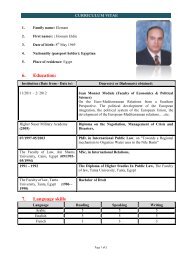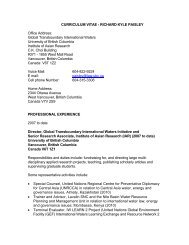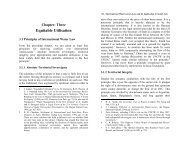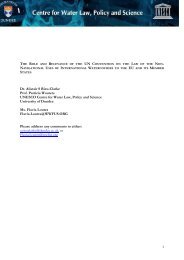Upreti, Trilochan, International Watercourses Law and Its Application ...
Upreti, Trilochan, International Watercourses Law and Its Application ...
Upreti, Trilochan, International Watercourses Law and Its Application ...
Create successful ePaper yourself
Turn your PDF publications into a flip-book with our unique Google optimized e-Paper software.
228 / <strong>International</strong> <strong>Watercourses</strong> <strong>Law</strong> <strong>and</strong> <strong>Its</strong> <strong>Application</strong> in South Asia Prospects <strong>and</strong> Problems of Nepalese Water Resources / 229project. 144 This could in fact form the basis for negotiationsaimed at resolving one of the outst<strong>and</strong>ing issues between India<strong>and</strong> Nepal.In order to share the downstream benefits co-operation isessential. The prerequisite for achieving or sharing these kindsof broader benefits are co-operation, good neighbourlyrelations, <strong>and</strong> good faith between the riparian states. That is tosay, in the absence of any investment of money, effort ortechnology by the lower riparian country, if hard work <strong>and</strong>investment is put into any water resources project in a boundaryor transboundary watercourse, <strong>and</strong> such work yields any benefitto the downstream country (e.g. augmentation of water, floodmodernisation, navigation, power generation, recreation,fisheries), benefits must be paid for by the beneficiary inproportion to the cost <strong>and</strong> benefits. Avoided cost theory (amethod of allocating costs <strong>and</strong> benefits in water projects) willbe helpful in assessing benefits; as a case in point, it seems thatNepal is willing to sell power to India at the alternative thermalor nuclear replacement cost, plus generation cost. 145This issue has been recognised in India in principle as well asin practice. For example the Indian River Act of 1956, Section15 (4), has recognised the downstream benefit concept. ThisAct provides that in the preparation <strong>and</strong> execution of schemesby the Board it shall take into account the costs likely to beincurred in constructing <strong>and</strong> maintaining such works; <strong>and</strong> thecosts shall be allocated among the interested governments insuch proportion as may be agreed or, in default of agreement,“as may be determined by the Board having regard to thebenefits which will be received from the scheme by them.” 146In addition, a committee constituted by the Government of144 Supra note 78, pp. 51-57; also see R. Paisley, “Adversaries intoPartners: <strong>International</strong> Water <strong>Law</strong> <strong>and</strong> the Equitable Sharing ofDownstream Benefits” (2002) in 3 MJIL, pp. 280-300.145 Supra note 22, p. 282.146 Ibid.India has recommended that such benefits must be sharedbetween the states concerned; this report was submitted to theIndian government in 1961. 147 Furthermore, it seems that theIndian government has practised the idea of sharing the benefitsproportionately in the interstate sphere of India. The Ministryof Irrigation <strong>and</strong> Power wrote to all state Governments on April17, 1967, stating that the cost of multipurpose river valleyprojects should normally be allocated only to three functions:irrigation, power <strong>and</strong> flood control. The letter recommendedthe “facilities used” method of allocation of joint costs inpreference to the “alternative justifiable expenditure” or“separable costs, remaining benefits” methods. 148In the United States of America, the principles of downstreambenefits have also been practiced in the interstate sphere. Forexample, Section 10 (f) of the Federal Power Act, 1935,imposes on the Federal Power Commission the duty todetermine the benefits to downstream plants from upstreamstorage, <strong>and</strong> assess charges against those downstream plants. 149In fact, the United States has remained fertile l<strong>and</strong> for theenunciation of the principle of equitable apportionment, which147 Ibid. p. 323: The Yadav Mohan Committee was appointed by theGovernment of India in 1961 to examine the levy of charges forutilisation of water on a downstream project. The committeerecommended as follows: “when an upstream project is constructedlater than an existing downstream project, the latter shall be liable topay for the benefit obtained from an upstream project irrespective ofthe period that has elapsed after its construction; but when thedownstream project is constructed after the upstream project, thedownstream project need pay for the benefits received only if it isconceived within 20 years of completion of the upper project. In eithercase the charge will be borne only if it is clearly established that thedownstream project has been benefited by the changes in flows orotherwise by the construction or operation of the upstream project. Thelower project will bear the cost to the extent that the actual additionalbenefits are made available to it <strong>and</strong> as <strong>and</strong> when these benefitsaccrue”.148 Ibid. p. 324.149 Ibid.












